Abstract
The rapid development of 5G and next-generation wireless systems has increased the demand for antennas that support circular polarization (CP), wide frequency coverage, and a compact size. Achieving wideband CP performance in a low-profile and simple structure remains a key challenge for modern antenna designs. In response to this, this paper presents a compact wide-slot antenna with a single feed, offering a wide operational bandwidth and circularly polarized radiation. The proposed design is excited by a 50 Ohm microstrip feedline, and it is fabricated on an (54 × 50 × 1.6 mm3) FR4 dielectric substrate. On the bottom side of the dielectric substrate, the ground plane is engraved to form a square-shaped radiating slot. The shape of the tuning stub of the antenna is modified in order to attain a wide impedance bandwidth and an axial ratio bandwidth (ARBW). The modifications include inserting a rectangular strip and thin horizontal strips into the tuning stub after tapering its upper corner. On the other hand, the radiating slot is appended by two rectangular stubs. The radiation of the resulted structure has right-hand circular polarization (RHCP). The measured results of the proposed antenna show a −10 dB impedance bandwidth equal to 78% (2.65 GHz, 2.08–4.73 GHz), whereas its broadside 3 dB ARBW is 71.6% over the frequencies (2.31 GHz, 2.07–4.38 GHz), which is compatible with various wireless communication applications. Furthermore, the peak value of the measured gain is equal to 4.68 dB, and its value is larger than 2 dBi along the operational bandwidth of the antenna.
1. Introduction
Antennas with circular polarization (CP) play a vital role in many contemporary communication applications due to their features of defying the multipath interference and polarization mismatch between the transmitter and the receiver as well as their immunity against the Faraday rotation [1,2]. Therefore, the issue of losing the line of sight path between the transmitter and the receiver can be mitigated with the aid of this antenna radiation. Consequently, these types of antennas have been used in numerous applications, such as WiMax, WLAN, satellite communications, RFID, and 5G applications [1].
There are different methods for designing antennas with CP, depending on the applications for which they are intended. Narrow-band CP antennas were proposed in [3,4,5]. Some dual-band antennas were designed by using an asymmetrical slot [6], a slot antenna with a parallel split-ring resonator [7], and stacked patches with reactive impedance surfaces for ISM and WiMax applications [8]. Multiband CP antennas were generated in [9,10] by using a Minkowski fractal slot for many frequency bands [9], and a multiband ultra-high-frequency (UHF) antenna for RFID applications was presented in [10]. To generate wideband dual CP antennas, aperture-coupled stack patches were designed in [11]. The patches are fed by a hybrid coupler to obtain an axial ratio bandwidth (ARBW) of 29.1% extended along the range (4.7–6.3 GHz). In [12,13], MIMO antennas were proposed. A four-element MIMO G-shaped monopole antenna was presented as a dual CP with an ARBW of 67.7% [12]. A wideband CP monopole antenna was proposed by using a co-planar waveguide (CPW)-fed approach [14,15]. Broadband C-shaped CP monopole antennas were presented in [16,17,18]. In [19], a cross-shaped monopole antenna was designed to obtain an ARBW of 42.6%. Recently, a 2 × 2 metasurface antenna array was proposed in [20] by using nonuniform slots to improve the ARBW to 61.75%.
Wide-slot antennas have been designed to generate wideband CP as a radiating element due to their advantages of achieving a wider impedance BW, weak coupling with the nearby electric components, and ease of fabrication [21]. For these reasons, they have been adopted in this work. In [22,23,24], narrow-band CP slot antennas were proposed. An artificial magnetic conductor (AMC) reflector with a Γ-shaped microstrip line was proposed to feed the slot antenna in [22] to achieve an impedance BW of 40.78% and an ARBW of 39.02%. For 5G techniques, an air-filled substrate-integrated waveguide (AF-SIW) CP slot antenna array was proposed in [24] to obtain an antenna BW of 18.4% and an ARBW of 16.4%. An L-shaped slot antenna was proposed in [24] in which a square-loop sequential-phase feeding structure was used to feed the antenna to generate an impedance BW of 18% and an ARBW of 13.2%. In [25], a wide-slot antenna was proposed for an ultra-wideband (UWB) frequency range with two band notches. ARBWs equal to 55.0% and 29.3% were achieved in [26], which is a dual-wideband slot antenna and dual-sense CP with overall dimensions of 50 × 50 × 1.0 mm3. Slot antennas that are fed by CPW were presented in [27,28,29,30]. A circular slot in the ground plane was utilized for generating CP in [31,32,33]. For a digital cellular system, an asymmetric wide-slot antenna was presented in [34]. A broadband wide-slot antenna was proposed in [35] for the mid-band of 5G applications. In [36], a square-shaped open-loop feeding structure was utilized to feed a split-ring resonator slot antenna to achieve an impedance BW and ARBW of 10.48%. Irregularly shaped square-slot antennas were realized in [37,38] with an inverted L-shaped and F-shaped microstrip feed, respectively. An antenna BW and ARBW approximately equal to 94.3% and 76.9%, respectively, were attained using an open-slot antenna [39]. A square-slot antenna with an L-shaped microstrip feed was designed to obtain an ARBW of 54.2% [40]. A square-ring slot antenna is fed by an L-shaped feedline to generate an ARBW of 3.7 GHz from 4.75 to 8.45 GHz [41]. An improved hybrid metasurface (IHMS) is utilized in a 2 × 2 antenna array with four corner cut patches to achieve a wide ARBW of 2.85 GHz [42]. However, such metasurface-based designs often involve increased structural complexity, higher fabrication costs, and potential challenges in terms of scalability and integration. Moreover, recent advances in the use of metamaterial-inspired resonators for antenna miniaturization and wavefront control offer promising directions for future research. Such techniques could be integrated with the proposed wide-slot structure to achieve further performance enhancement while significantly reducing the antenna size [43,44,45]. Notably, metasurface-based CP antennas have emerged as a promising solution to achieve a wide bandwidth with compact geometries [46,47]. Meanwhile, the integration of artificial intelligence and machine learning techniques has begun to influence antenna design, enabling data-driven optimization of CP performance metrics [48]. In recent years, numerous wideband CP antennas have been proposed utilizing techniques such as fractal geometries [49] and reconfigurable structures [50]. While these designs often achieve excellent performance, they typically involve complicated configurations, and they require external biasing circuits. In contrast, the antenna proposed in this study offers a simple and cost-effective solution while maintaining competitive performance within the targeted frequency band.
The choice of wideband circular polarization ensures consistent performance across multiple potential operating bands within the sub-6 GHz spectrum, which is crucial for modern systems that require frequency agility and interoperability with different 5G and IoT standards. In addition, it offers significant advantages, especially in scenarios involving mobility, multipath environments, and polarization mismatch, such as user terminals or indoor to outdoor links. A multi-band antenna, for example, a tri-band antenna, would limit the operation to fixed frequencies, which is less flexible and might lead to poor performance in between bands. Therefore, a wideband circular polarization antenna can better address the dynamic requirements of sub-6 GHz 5G and related wireless applications, making it more suitable for current and future deployment scenarios.
In 5G systems, the receiver plays a vital role in capturing and processing incoming radio frequency signals to extract the transmitted data. A typical 5G receiver architecture consists of a radio frequency front-end that performs signal filtering and low-noise amplification, and they are followed by a frequency down-conversion stage that shifts the RF signal to an intermediate frequency or directly to baseband. The key challenges for 5G receivers include supporting wide bandwidths, operating at high frequencies while maintaining a low noise figure, and achieving high energy efficiency. The performance of the receiving system is highly dependent on antenna characteristics such as the polarization, gain, and bandwidth, which directly affect the signal-capturing quality and system reliability in a dynamic wireless 5G environment.
This paper presents a new and compact wide-slot antenna that is fed by a 50 Ω microstrip feedline. By adding three strips to the tuning stub and modifying the slot of the ground plane by attaching a rectangular stub and parasitic patch, a wideband impedance BW and ARBW are obtained. For validation, the proposed antenna is fabricated, and its performance is assessed by a laboratorial test. The simulated and measured results show the good coverage of the antenna BW and a broadside ARBW along a wide range of frequencies that are applicable for various wireless communication applications. It is found that the measured −10 dB impedance BW is 78% (2.65 GHz, 2.08–4.73 GHz), while the broadside 3 dB ARBW is 71.6% along the range (2.31 GHz, 2.07–4.38 GHz). This work has been compared with other well-known wide-slot antennas, and the comparison shows that the proposed design makes a compromise between the size reduction and the gain value so that it is superior to the other designs.
2. Antenna Structure
The geometry of the proposed wide-slot antenna is exhibited in Figure 1. The antenna is etched on an FR4 substrate with a dielectric constant of = 4.3, height of h = 1.6 mm, and loss tangent of tan = 0.025. The overall dimensions of this antenna are 54 × 50 × 1.6 mm3, which is equivalent to 0.39λ × 0.36λ × 0.0117λ, where λ is the free-space wavelength corresponding to the lowest resonant frequency. The tuning stub of the antenna is fed by using a 50 Ω microstrip feedline, while the ground plane is engraved as a square slot on the bottom surface of the dielectric substrate. To obtain good coupling and achieve wideband CP, modified strips and stubs are added to the tuning stub and the wide slot. All the key parameters that improve the CP performance are studied in Section 5. Simulated results of the proposed antenna are acquired by using the CST Microwave Studio Suite.
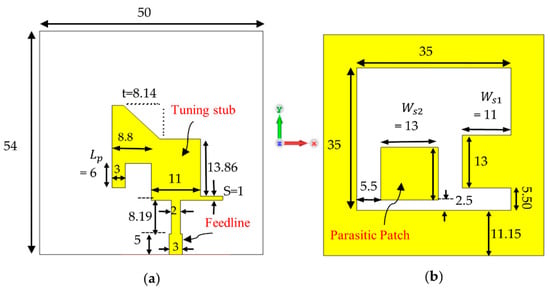
Figure 1.
Structure of the proposed antenna: (a) front view and (b) back view (unit: mm).
The proposed wide-slot antenna is based on a modified feeding mechanism and an optimized slot geometry. Starting from the conventional rectangular slot antenna, this design improves the impedance matching and the ARBW by leveraging the parasitic and strip elements of the design. Therefore, these strategies contribute to achieving wideband CP while maintaining a compact size to make it useful in many wireless communications applications, such as ISM bands (2.4–2.5 GHz), WiMAX (2.3–3.8 GHz), and C-band (3.3–4.2 GHz).
3. Design Steps
The design procedure for the proposed antenna is illustrated in Figure 2, which follows (Ant. 1–Ant. 6) to reach the final structure. The simulation results of the reflection coefficient () and the broadside axial ratio (AR) of each antenna structure are demonstrated in Figure 3a and Figure 3b, respectively. Ant. 1 is comprised of a conventional wide-slot antenna with a rectangular tuning stub fed by a microstrip line. The length of the slot (L) is approximately equal to half the guided wavelength corresponding to the resonant frequency (2.2 GHz) L ≅ , where the guided wavelength is given by = λ/, λ is the free-space wavelength corresponding to the resonant frequency (2.2 GHz), and is the dielectric constant of the substrate. The impedance BW in this step is equal to 1.39 GHz and resonates at 2.3 GHz, while the AR value is much greater than 3 dB, which does not appear in the figure. In other words, there is no circular polarization in this case. A horizontal rectangular stub with a width of is protruded from the left side of the radiating slot in Ant. 2, which shifts the resonant frequency to 2.15 GHz with a narrow impedance BW of 510 MHz due to the increase in the surface current path around the radiating slot, while the AR appears less than 3 dB because two orthogonal fields are generated. The specific shape and dimensions of the rectangular stub in Ant. 2 were determined through parametric studies aimed at optimizing the axial ratio performance. Although the geometry of the parasitic element is novel, the approach is based on previous studies working on CP antennas. For instance, studies have demonstrated that incorporating parasitic elements can significantly enhance the circular polarization characteristics by introducing additional orthogonal resonances that lead to attaining low AR values [26]. Thereby, this antenna provides CP with a narrow ARBW of 960 MHz. In Ant. 3, a rectangular strip is integrated into the edge of the tuning stub, which enhances the horizontal path of the current, and the AR has been improved significantly to extend along the range (1.9–4.4 GHz) with an ARBW of 2.5 GHz. Meanwhile, the impedance matching of the antenna is lost because the coupling between the feedline and the radiating slot has deteriorated. The mismatch in the impedance is reduced in Ant. 4. It shows that the tuning stub and feedline are translated to the right to add an additional resonant frequency. In addition to this, a vertical strip with a length of is placed on the tuning stub to obtain an impedance BW of 810 MHz from 1.86 to 2.67 GHz. Ant. 4 just improves the impedance matching that was lost in Ant. 3. By cutting the upper corner of the tuning stub, Ant. 5 provides better performance for impedance matching than Ant. 4. The ARBW extends along a wide range from 1.96 to 4.64 GHz because this tapering tunes both the horizontal and vertical current components in such a way that generates two orthogonal equal magnitude components. Finally, Ant. 6 is presented to tune the coupling between the feedline and radiating slot to obtain a wideband impedance BW and ARBW by adding the rectangular parasitic patch to the slotted ground directly behind the tuning stub and attaching the horizontal strip to the tuning stub. The resulting structure provides an impedance BW of 2.8 GHz (1.90–4.7 GHz) and a 3-dB ARBW of 2.52 GHz along the range (1.90–4.42 GHz). Specifically, the work in [33] stated that a combination of a symmetrical slot length and a rectangular parasitic patch successfully enhanced the 3 dB ARBW.
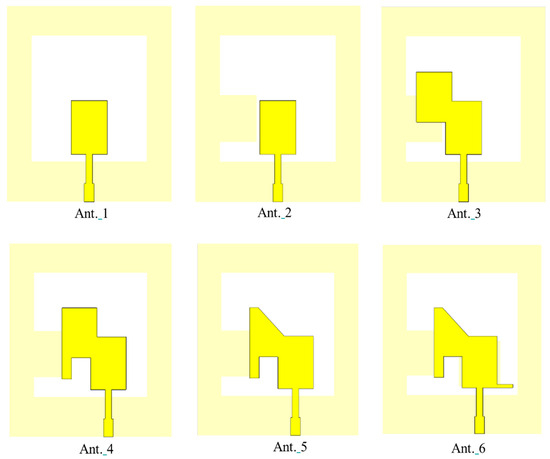
Figure 2.
Design steps for the proposed wide-slot antenna.
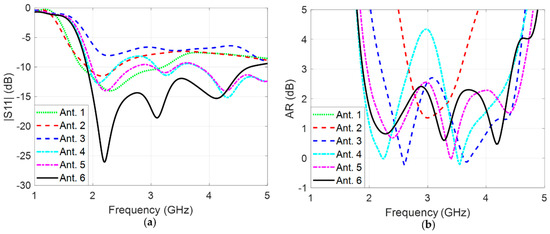
Figure 3.
Simulation results of the proposed wide-slot antenna design steps: (a) reflection coefficient and (b) AR.
Figure 4 shows the position of the parasitic strip on the slotted ground plane with respect to the tuning stub. To explain the importance of adding this strip in terms of the and AR, Figure 5a and Figure 5b, respectively, depict the simulation results with and without the parasitic strip. It is clear from Figure 5a,b that the parasitic patch has an enormous effect on the impedance BW and a very subtle effect on the ARBW. The reason behind this is that the parasitic patch improves the coupling between the feedline and the radiating slot without modifying the current direction or the phase angle. The location of the rectangular parasitic patch is chosen behind the rectangular tuning stub, and its shape follows the original shape of the stub. The location is also selected in such a way that it does not overlap with the ground plane to improve the coupling between the feedline and the slot.
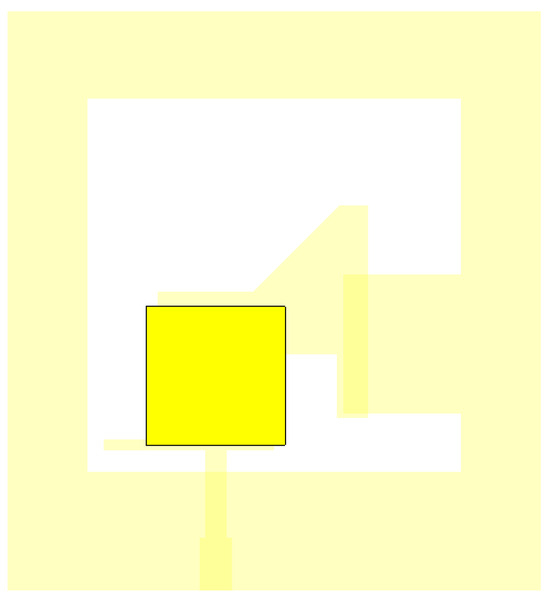
Figure 4.
The location of the rectangular parasitic patch with respect to the tuning stub.
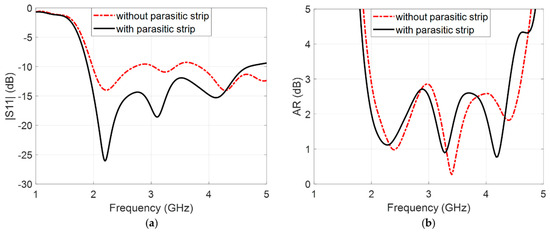
Figure 5.
Simulation results of the (a) reflection coefficient and (b) AR without and with the parasitic patch.
The shape of the proposed antenna is unique compared to other wide-slot antennas. The proposed design has multi-section asymmetric tuning stub and additional parasitic patches at the ground plane, which are completely different from the tuning stubs and ground structures used in [25,35,51]. This design enhances the circular polarization by effectively exciting the orthogonal modes. Additionally, the asymmetric wide-slot structure in the ground plane differs from typical rectangular or elliptical slots, contributing to generating a wider AR bandwidth. These structural innovations clearly distinguish the proposed antenna from prior works.
Like the other wide-slot antenna designs, the tuning stub shape is carefully designed to optimize the line-slot coupling of the antenna. Meanwhile, the single-feed microstrip line for the CP antenna was chosen because it reduces the design complexity compared to dual-feed antennas. This mechanism is simple since it generates circular polarization through the slot geometry without the need for complicated external networks. Additionally, it is compatible with compact devices, such as smartphones and IoT devices, where a small size is required. The designed antenna size is suitable for the following applications:
- -
- 5G sub-6 GHz (3.4–3.8 GHz), which requires compact size devices such as smartphones.
- -
- IoT systems and Wi-Fi 6E (2.4–5 GHz), which also require small-sized devices with a wide range of frequencies.
4. Circular Polarization Generation Mechanism
The current distribution of the proposed antenna is illustrated in Figure 6 at 2.2 GHz to verify the presence of CP. To achieve CP, two orthogonal resonant modes with equal amplitudes and phase differences equal to 90° should be presented. These orthogonal paths can be provided by inserting a number of horizontal and vertical strips into the tuning stub and the ground plane. These strips can control the length of the horizontal and vertical current paths to concur with the conditions of the CP mentioned above.
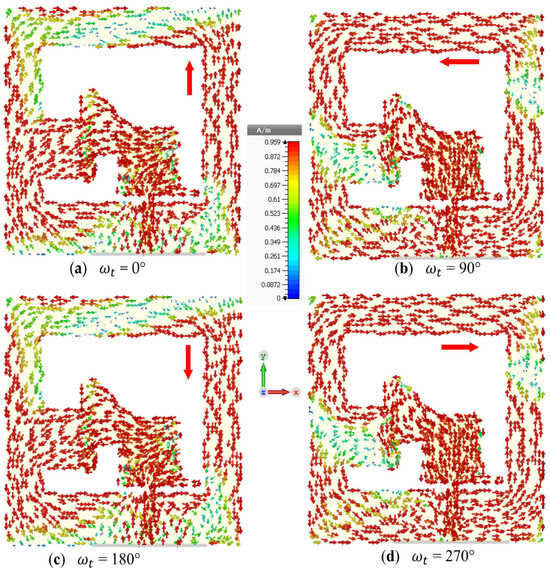
Figure 6.
Simulated current distribution of the proposed antenna at 2.2 GHz at different time instants. (a) = 0°; (b) = 90°; (c) = 180°; (d) = 270°.
In Figure 6a–d can be observed the different time instants ( = 0°, 90°, 180°, and 270°), respectively. For wide-slot antennas, the antenna radiation comes from the slot engraved in the ground plane, so the current around the slot determines the polarization of the antenna at different time instants. At = 0°, the current vectors are demonstrated along the positive y-axis direction along the radiating slot, while at = 90°, the current vectors are demonstrated in the negative x-axis direction. At = 180° and 270°, the current distribution is in the opposite direction of phases at = 0°, and 90°, respectively. The rotation of the current in an anti-clockwise direction is clearly seen, which means that it is a right-hand circular polarization antenna with respect to the positive z-axis. By mirroring the presented antenna with respect to the y-axis, left-hand circular polarization (LHCP) can be generated.
5. Parametric Study
In this section, the effects of some key parameters on the and the AR in the broadside direction are studied. These parameters include the width of the rectangular strip in the ground plane (), the length of a vertical strip (), the cutting depth of the tuning stub (t), the width of the parasitic strip (), and the width of a thin horizontal strip (S). As mentioned previously, every parameter participates in generating CP withwide frequency coverage.
Figure 7a,b reveal the and AR, respectively, at different values of while keeping other parameters at their optimum values. This parameter improves the coupling between the stub and the radiating element at the first resonant frequency. Since this rectangular strip controls the length of the current path around the radiating slot, the impedance matching is shifted toward a lower frequency band. It is evident that it significantly introduces a wide range of CP because it provides a path perpendicular to the original path of the conventional rectangular slot. equal to 11 mm gives the best results for the ARBW and impedance BW.
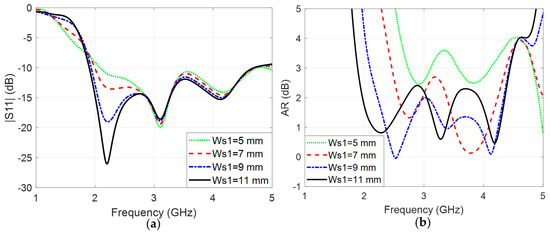
Figure 7.
Simulation results of the proposed antenna with = 6 mm, t = 8.14 mm, = 13 mm, S = 1 mm, and different values of : (a) reflection coefficient and (b) AR.
The effect of the length of the vertical strip is exhibited in Figure 8. As can be seen from Figure 8a, the different values of slightly impact the coupling in the impedance matching at 4.2 GHz, while they have no effect in the lower band. The reason for this is that the tuning stub does not contribute in the radiation of the antenna, and it does not control the radiating current path. For the same reason, the mismatching at the upper frequency band of the ARs can be decreased by tuning as in Figure 8b. It extends the CP bandwidth to the highest frequency band when its optimum value of 6 mm is attained.
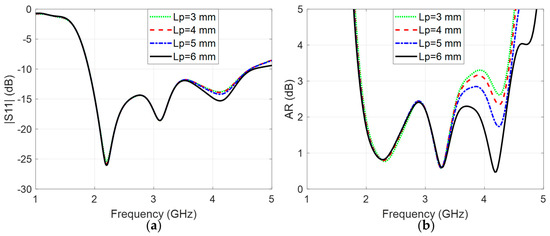
Figure 8.
Simulation results of the proposed antenna with = 11 mm, t = 8.14 mm, = 13 mm, S = 1 mm, and different values of (a) reflection coefficient and (b) AR.
Figure 9a,b display the and AR at different depths of the truncated corner t. It has a minor impact on the reflection coefficient because it does not affect the line-slot coupling of the antenna. This truncation exhibits a significant effect to make AR less than 3 dB at 2.9 GHz when t is equal to 8.14 mm. This means that it controls the phase orthogonality between the current modes of the antenna, but it has a minor effect on their amplitudes.
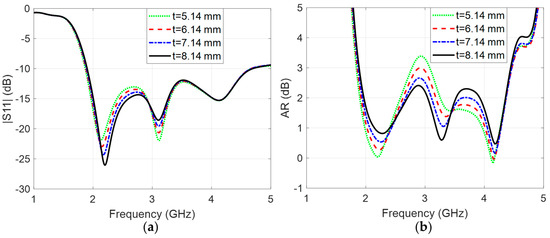
Figure 9.
Simulation results of the proposed antenna with = 11 mm, = 6 mm, = 13 mm, S = 1 mm, and different values of t: (a) reflection coefficient and (b) AR.
The and AR of the parameter are shown in Figure 10a and Figure 10b, respectively. The parasitic strip () plays an essential role in achieving both phase orthogonality and improved impedance matching. A parametric study on the width of this strip, as shown in Figure 10, demonstrates its significant influence on the antenna’s performance. Specifically, when = 13 mm, the design achieves optimal matching across the three resonance frequencies, along with the lowest axial ratio within the desired band. This is because enhances the excitation of the orthogonal modes by modifying the horizontal surface current distribution while simultaneously contributing to better impedance matching by tuning the location of the resonant frequencies.
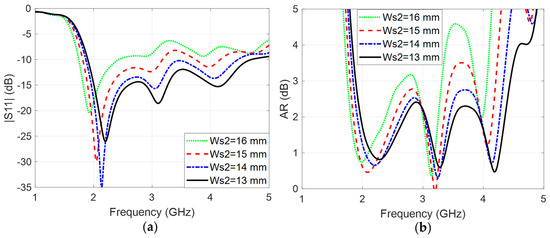
Figure 10.
Simulation results of the proposed antenna with = 11 mm, = 6 mm, t = 8.14 mm, S = 1 mm, and different values of : (a) reflection coefficient and (b) AR.
Figure 11 illustrates the effect of changing the width of the horizontal strip attached to the tuning stub on the and AR. Since it is a part of the tuning stub, the impedance matching is extended to the upper side of the frequency as S decreases. Meanwhile, it contributes to obtaining a wide ARBW at the higher frequency band by reducing the mismatching at 3.7 GHz to reach its optimum value of 1 mm. The effect of the width of the horizontal strip (S) appears for values larger than 1 mm because it generates a vertical current component that distorts the orthogonality of the orthogonal current paths.
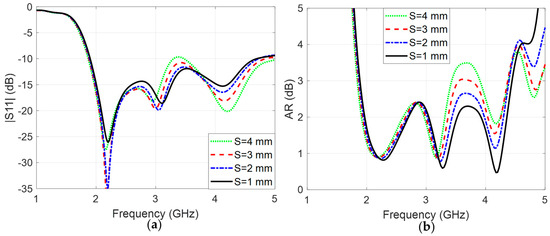
Figure 11.
Simulation results of the proposed antenna with = 11 mm, = 6 mm, t = 8.14 mm, = 13 mm, and different values of S: (a) reflection coefficient and (b) AR.
It is known that FR4 introduces higher dielectric losses at frequencies above 3 GHz, which can impact the radiation efficiency and bandwidth. This effect was considered during the design, and the antenna dimensions were optimized accordingly to achieve acceptable performance within the target frequency band. Future work could involve the substrate optimization by replacing FR4 with low-loss dielectric materials such as Rogers RO4003C, RO4350B, or RT/Duroid 5880, which offer significantly lower loss and more stable dielectric constants to improve the bandwidth and gain. Additionally, adaptive metamaterials could be used to adjust the antenna characteristics, offering enhanced reconfigurability and performance. To evaluate the robustness of the antenna performance to manufacturing variations in the dielectric constant of the FR4 substrate, a parametric sweep of 4.1, 4.3, and 4.5 was performed. The results indicate that there is a minor impact on the impedance bandwidth and axial ratio bandwidth. This analysis confirms that the design is tolerant of typical material variations, and FR4 remains a practical choice considering the cost, availability, and fabrication constraints. It is worth noting that this analysis was included for completeness, although the dielectric constant of FR4 is generally well characterized and its impact on performance is well understood in the literature. Figure 12 shows the sensitivity analysis of the variations on the reflection coefficient and axial ratio.
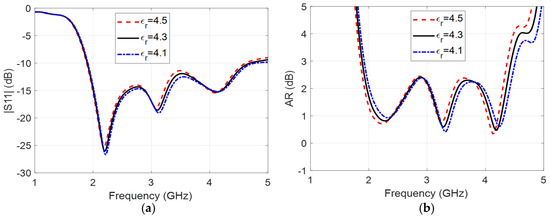
Figure 12.
Sensitivity analysis of the variations on the (a) reflection coefficient and (b) AR.
The simulated normalized LHCP and RHCP power patterns of the proposed antenna are displayed in Figure 13 for the YZ-plane and XZ-plane at three resonant frequencies: 2.2 GHz, 3.1 GHz, and 4.2 GHz. It can be seen that the antenna operates as an RHCP antenna for both planes in the broadside direction ( = 0°) in the positive z-axis direction. By mirroring the shape of the presented antenna with respect to the y-axis, LHCP can be generated in the broadside direction.
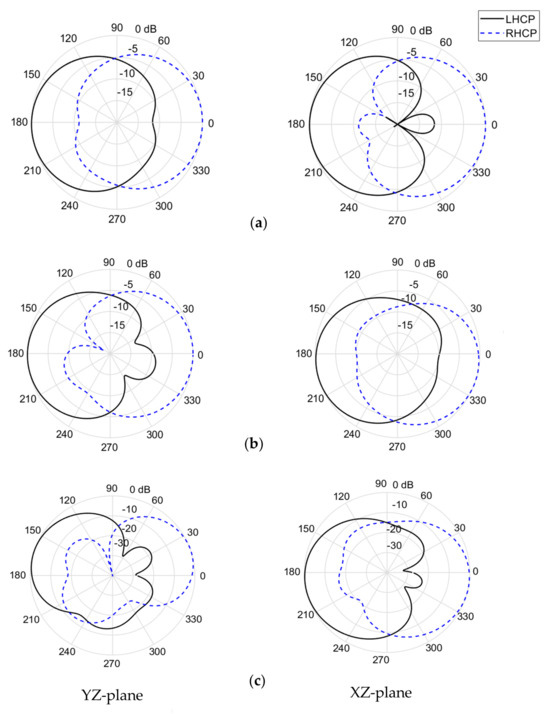
Figure 13.
Simulated LHCP and RHCP patterns of the proposed antenna at (a) f = 2.2 GHz, (b) f = 3.1 GHz, and (c) f = 4.2 GHz.
The simulated 3D normalized power pattern of the proposed antenna is demonstrated in Figure 14 at the resonant frequency of 2.2 GHz. This pattern provides a comprehensive view of the antenna’s radiation behavior in space and is essential for evaluating its directional characteristics and overall radiation performance.
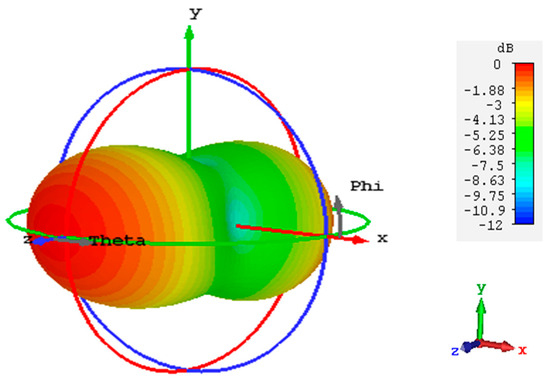
Figure 14.
Simulated 3D normalized power pattern of the proposed antenna at f = 2.2 GHz.
6. Measured Results
The front and back views of the prototype of the presented wide-slot antenna are illustrated in Figure 15a and Figure 15b, respectively. It should be noted that the measured reflection coefficient is achieved with the help of the Amitec VNA40 network analyzer. The measurement setup of the radiation pattern, axial ratio, and gain is exhibited in Figure 16a inside an anechoic chamber, while Figure 16b shows the CNC milling machine (LPKF ProtoMat S42) used for fabricating the proposed antenna.
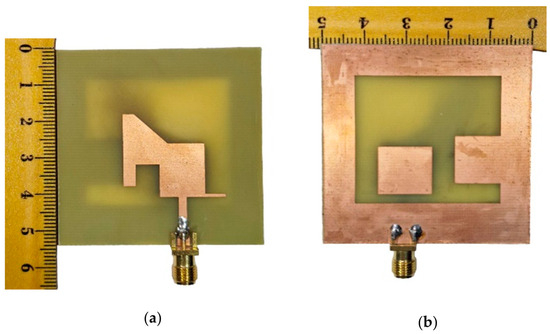
Figure 15.
The prototype of the proposed wide-slot antenna: (a) front view and (b) back view.
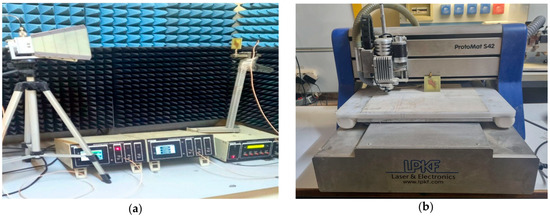
Figure 16.
(a) The measurement setup of the radiation pattern, AR, and gain, and the (b) LPKF CNC machine.
The antenna was fabricated using an FR4 substrate manufactured by pwcircuits.co.uk Canal Street, South Wigston, Leicester LE18 4PN, UK (h = 1.6 mm, = 4.3) with 0.035 mm copper thickness. To fabricate the antenna layout, the design was first exported from the simulation software (CST) [52] in the Gerber file format, which is the industry-standard format for PCB manufacturing. This file was imported by the LPKF CircuitPro CAM software, which converted for the CNC milling machine (LPKF ProtoMat S42) manufactured by LPKF (Tianjin) Co., Ltd. Tianjin, China (100%) as shown in Figure 16b. This allowed the machine to accurately remove the unwanted copper areas and realize the antenna structure on the FR4 substrate.
The simulated and measured results of the and Ars are demonstrated in Figure 17a and Figure 17b, respectively. The BW is calculated based on (, for simulated results) and (, for measured results), which are marked in the figure. These frequencies represent the lower and upper cutoff frequencies, respectively, where the BW criterion is satisfied (|| < −10 dB and AR < 3 dB). The simulated −10 dB impedance BW is equal to 2.8 GHz (85%) along the range (1.90–4.7 GHz), while the measured −10 dB impedance BW is 2.65 GHz (78%) (from 2.08 to 4.73 GHz). On the other hand, the simulated 3 dB ARBW is 2.52 GHz (80%) extending along the range (1.90–4.42 GHz), whereas the measured 3 dB ARBW is equal to 2.31 GHz (71.6%) over the frequency range (2.07–4.38 GHz). The difference between the simulated and measured results can be attributed to several factors. These factors include fabrication tolerances and imperfections in the SMA connector soldering. The measurement setup limitations includereflections from nearby equipment inside the anechoic chamber or cable losses. Additionally, parasitic effects of the SMA connector can lead to an impedance mismatch, causing a slight shift in the resonance frequency. Moreover, substrate moisture absorption, especially in FR4 materials, may increase the effective dielectric constant, resulting in a lower resonant frequency and reduced bandwidth.
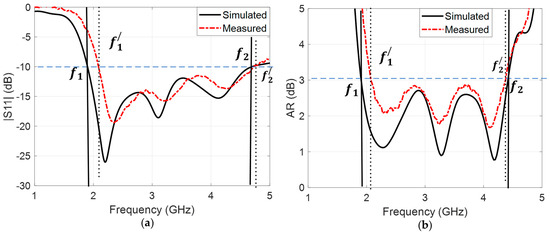
Figure 17.
Simulated and measured results of the proposed antenna: (a) reflection coefficient and (b) AR.
Figure 18 depicts the simulated and measured results of the realized gain as a function of the frequency. This figure shows gain values larger than 2 dBi along the antenna BW. At 4.73 GHz, a peak gain can be observed, which is equal to 4.68 dBi.
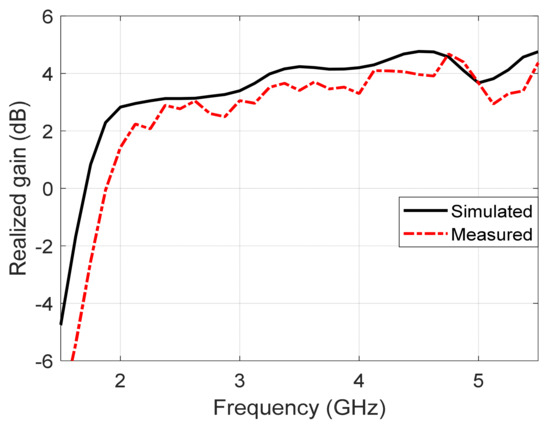
Figure 18.
Simulated and measured realized gain of the proposed antenna as a function of the frequency.
The realized gain values shown in Figure 18 are based on both simulation and experimental measurements. The measurements were conducted in an anechoic chamber using the gain comparison method in which a standard horn antenna was used as a reference (see Figure 16a). To ensure the accuracy and reliability of the measured gain, the measurement setup was carefully calibrated prior to testing, and a standard horn antenna with known gain was used. The measured gain values were compared with the simulated results and a reasonable agreement was observed, confirming the validity of the presented data. Accordingly, the gain values in Figure 18 accurately reflect the practical performance of the proposed antenna design.
The simulation tools were used to estimate the radiation efficiency of the antenna, which varies from approximately 93% at 2 GHz to 85% at 4.7 GHz. This drop in efficiency is primarily due to the high loss tangent of the FR4 substrate, whose attenuation increases as the frequency increases. Despite this, the antenna maintains gain levels above 2 dBi throughout the band, confirming its suitability for real-world applications such as 5G sub-6 GHz systems, Wi-Fi 6E, and compact IoT devices, where the trade-offs between cost, size, and performance are critical.
The simulated and measured co-polarized and cross-polarized radiation patterns of the proposed antenna are presented in Figure 19 at the YZ- and XZ-planes at the three resonant frequencies. The evidence of the presence of CP in the broadside direction () is that the co- and cross-polarization radiation patterns are close to each other with a difference of less than 3 dB between them for both planes at this direction of propagation.
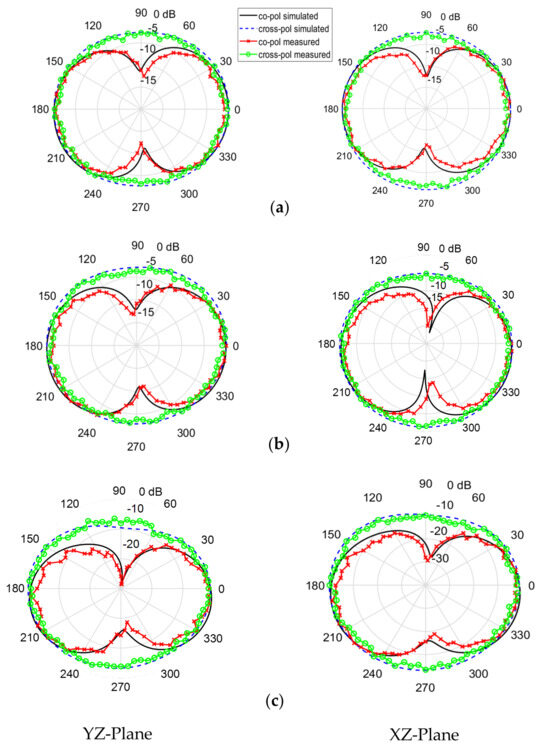
Figure 19.
Simulated and measured results of the normalized co- and cross-polarization power patterns of the proposed antenna at (a) f = 2.2 GHz, (b) f = 3.1 GHz, and (c) f = 4.2 GHz.
Briefly put, this design is a wide-slot antenna that has a wide impedance BW and a wide ARBW in spite of its small dimensions. In addition, the gain value is accepted along the impedance BW. Furthermore, the radiation pattern is stable along the operational band. However, the disadvantage of the wide-slot antenna lies in the complicated steps that are followed to accommodate the shape of the slot with the shape of the tuning stub to achieve reasonable line-slot coupling.
The effective noise temperature of the antenna as a function of the frequency should also be highlighted in this work to demonstrate the effect of the galactic noise and the atmospheric noise on the antenna performance. In fact, several references provide empirical data and equations about the effective noise temperature and its variation with respect to the galactic noise and atmospheric noise, which includes the humidity and water vapor effects. However, reference [53] has specifically discussed the effective noise temperature of the antenna as a function of the frequency. It is shown that the galactic noise effect decreases gradually as the frequency increases until it reaches its minimum values at frequencies above 1 GHz. In contrast, the atmospheric noise (including the humidity and water vapor) effect increases as the frequency increases, but its effect is subtle at frequencies below 10 GHz. As a result, the effective noise temperature of the antenna is minimal within the range (1–10 GHz). It is important to note that the proposed design has a bandwidth within the given range, so the atmospheric and galactic noise has a negligible effect on its performance.
As summarized in Table 1, the proposed antenna exhibits competitive performance when compared to state-of-the-art wide-slot CP antennas. Notably, it achieves a wide 3 dB axial ratio bandwidth (2.08–4.37 GHz), a high peak gain of 4.68 dB, and excellent radiation efficiency of 93% at the first resonant frequency, while maintaining a compact size (0.39λ × 0.36λ × 0.011λ at 2.2 GHz) with the aid of a low-cost FR4 substrate. Compared to designs based on high-performance substrates such as Rogers 5880 or 4350B, the proposed design demonstrates superior or comparable performance using a more economical material. Additionally, unlike several references that focus on narrowband or single-band operation, this antenna supports broadband circular polarization suitable for multi-standard applications such as sub-6 GHz 5G, WiMAX, and Wi-Fi. It can be observed that although some referenced designs, such [33,51], achieve higher peak gains, they require significantly larger antenna dimensions. This reflects a common trade-off in antenna design, where achieving higher gain often comes at the cost of increased size. Moreover, both [33] and [51] exhibit a significantly narrower –10 dB impedance bandwidth and a 3 dB axial ratio bandwidth compared to the proposed design. In contrast, the proposed antenna offers a compact structure along with much wider impedance and axial ratio bandwidth, which are crucial for stable circular polarization and broadband performance.

Table 1.
Comparison between the proposed antenna and other slot antennas.
It is worth mentioning that the proposed antenna is compared with other important wide-slot antennas. Some designs, such as in [16,17,18,19,58], have better ARBWs than our design, but they are monopole antennas (not wide-slot antennas). Unlike wide-slot antennas, monopole antennas have a strong undesired coupling with the nearby electrical components because the dominant near field component is the electric field [25]. In addition, the monopole antennas have an irregular radiation pattern along the wide frequency range [25].
7. Conclusions
A new wide-slot antenna has been designed to achieve wideband circular polarization with satisfactory axial ratio and impedance bandwidth while maintaining a compact antenna footprint. The proposed antenna has been fabricated and tested in this paper. This antenna consists of a microstrip line-fed tuning stub, slotted ground plane, strips, and stubs that are added to achieve a wide range of impedance BW and ARBW. This antenna generates CP in the broadside direction and radiates waves with broadband RHCP. The overall size of the presented antenna is 0.39λ × 0.36λ × 0.011λ. The measured −10 dB impedance BW is 78% along the range (2.08–4.73 GHz), and the ARBW is equal to 71.6% (2.07–4.38 GHz). The measured average gain has a good value of 3.34 dBi over the CP bandwidth. As a result of these properties, the proposed antenna can be used for various wireless CP communication applications. To build upon the proposed design, further optimization of the antenna geometry could be investigated to extend the axial ratio bandwidth ARBW and improve the gain stability across wider frequency ranges. Additionally, the use of reconfigurable or tunable elements can enable dynamic control over the polarization states. Moreover, the array configurations of this antenna could be studied for future 5G and 6G MIMO systems.
Author Contributions
Conceptualization, A.H.M. and F.M.A.; methodology, A.H.M.; investigation, A.H.M., F.M.A., Y.I.A.A.-Y. and S.C.E.; resources, A.H.M. and F.M.A.; writing—original draft preparation, A.H.M., F.M.A. and Y.I.A.A.-Y.; writing—review and editing, F.M.A., Y.I.A.A.-Y. and S.C.E.; visualization, A.H.M., F.M.A. and Y.I.A.A.-Y. All authors have read and agreed to the published version of the manuscript.
Funding
This research received no external funding.
Institutional Review Board Statement
Not applicable.
Informed Consent Statement
Not applicable.
Data Availability Statement
The original contributions presented in the study are included in the article, further inquiries can be directed to the corresponding author.
Conflicts of Interest
The authors declare no conflicts of interest.
References
- Gao, S.S.; Luo, Q.; Zhu, F. Circularly Polarized Antennas; John Wiley & Sons: Hoboken, NJ, USA, 2014. [Google Scholar]
- Guha, D.; Kumar, C.; Biswas, S. Defected Ground Structure (DGS) Based Antennas: Design Physics, Engineering, and Applications; John Wiley & Sons: Hoboken, NJ, USA, 2022. [Google Scholar]
- Alnahwi, F.M.; Al-Yasir, Y.I.; See, C.H.; Abd-Alhameed, R.A. Single-element and MIMO circularly polarized microstrip antennas with negligible back radiation for 5G mid-band handsets. Sensors 2022, 22, 3067. [Google Scholar] [CrossRef] [PubMed]
- Mohammed, A.H.; Alnahwi, F.M.; Al-Yasir, Y.I. A Circularly Polarized Microstrip Antenna with Dual Circular Polarization Using a 90° Hybrid Coupler and Proximity-Coupled Feeding for LTE 43 5G Applications. Appl. Sci. 2024, 14, 11877. [Google Scholar] [CrossRef]
- Sabran, M.I.; Abdul Rahim, S.K.; Leow, C.Y.; Soh, P.J.; Chew, B.W.; Vandenbosch, G.A. Compact circularly polarized truncated square ring slot antenna with suppressed higher resonances. PLoS ONE 2017, 12, e0172162. [Google Scholar] [CrossRef] [PubMed]
- Noghabaei, S.M.; Rahim, S.; Soh, P.; Abedian, M.; Vandenbosch, G. A dual-band circularly-polarized patch antenna with a novel asymmetric slot for WiMAX application. Radioengineering 2013, 22, 291–295. Available online: http://www.radioeng.cz/fulltexts/2013/13_01_0291_0295.pdf (accessed on 7 May 2025).
- Pirooj, A.; Naser-Moghadasi, M.; Zarrabi, F.B.; Sharifi, A. A dual band slot antenna for wireless applications with circular polarization. Prog. Electromagn. Res. C 2017, 71, 69–77. [Google Scholar] [CrossRef]
- Agarwal, K.; Dutta, S. Miniaturized Circularly Polarized Stacked Patch Antenna on Reactive Impedance Surface for Dual-Band ISM and WiMAX Applications. Int. J. Antennas Propag. 2015, 2015, 938565. [Google Scholar] [CrossRef]
- Remya, V.R.; Abraham, M.; Parvathy, A.; Mathew, T. Multiband circularly polarised microstrip patch antenna with minkowski fractal slot for wireless communications. Prog. Electromagn. Res. C 2021, 116, 65–80. [Google Scholar] [CrossRef]
- Gharbia, I.; Ullah, A.; Alnahwi, F.; Salisu, A.; Oguntala, G.; Ngala, M.; Abd-Alhameed, R. Multi-band UHF RFID Reader Antenna Design. In Proceedings of the 3rd International Multi-Disciplinary Conference: “Integrated Sciences and Technologies”, IMDC-IST 2023, Yola, Nigeria, 25–27 October 2023. [Google Scholar] [CrossRef]
- Ta, S.X.; Nguyen, V.C.; Nguyen-Thi, B.-T.; Hoang, T.B.; Nguyen, A.N.; Nguyen, K.K.; Dao-Ngoc, C. Wideband dual-circularly polarized antennas using aperture-coupled stacked patches and single-section hybrid coupler. IEEE Access 2022, 10, 21883–21891. [Google Scholar] [CrossRef]
- Kumar, S.; Lee, G.H.; Kim, D.H.; Choi, H.C.; Kim, K.W. Dual circularly polarized planar four-port MIMO antenna with wide axial-ratio bandwidth. Sensors 2020, 20, 5610. [Google Scholar] [CrossRef]
- Al-Yasir, Y.I.; Abdulkhaleq, A.M.; Parchin, N.O.; Elfergani, I.T.; Rodriguez, J.; Noras, J.M.; Abd-Alhameed, R.A.; Rayit, A.; Qahwaji, R. Green and highly efficient MIMO transceiver system for 5G heterogenous networks. IEEE Trans. Green Commun. Netw. 2021, 6, 500–511. [Google Scholar] [CrossRef]
- Alsariera, H.; Zakaria, Z.; Isa, A.; Al-Heety, O.S.; Zeain, M.; Abu-Khadrah, A.I.; Alahnomi, R.; Mabrok, M. Compact CPW-fed broadband circularly polarized monopole antenna with inverted L-shaped strip and asymmetric ground plane. Prz. Elektrotechniczny 2020, 4, 53–56. [Google Scholar] [CrossRef]
- Ding, K.; Guo, Y.-X.; Gao, C. CPW-fed wideband circularly polarized printed monopole antenna with open loop and asymmetric ground plane. IEEE Antennas Wirel. Propag. Lett. 2016, 16, 833–836. [Google Scholar] [CrossRef]
- Alnahwi, F.M.; Al-Yasir, Y.I.; Ali, N.T.; Gharbia, I.; See, C.H.; Abd-Alhameed, R.A. A compact wideband circularly polarized planar monopole antenna with axial ratio bandwidth entirely encompassing the antenna bandwidth. IEEE Access 2022, 10, 81828–81835. [Google Scholar] [CrossRef]
- Tang, H.; Wang, K.; Wu, R.; Yu, C.; Zhang, J.; Wang, X. A novel broadband circularly polarized monopole antenna based on C-shaped radiator. IEEE Antennas Wirel. Propag. Lett. 2016, 16, 964–967. [Google Scholar] [CrossRef]
- Ding, K.; Gao, C.; Yu, T.; Qu, D. Broadband C-shaped circularly polarized monopole antenna. IEEE Trans. Antennas Propag. 2014, 63, 785–790. [Google Scholar] [CrossRef]
- Gyasi, K.O.; Wen, G.; Inserra, D.; Huang, Y.; Li, J.; Ampoma, A.E.; Zhang, H. A compact broadband cross-shaped circularly polarized planar monopole antenna with a ground plane extension. IEEE Antennas Wirel. Propag. Lett. 2018, 17, 335–338. [Google Scholar] [CrossRef]
- Iqbal, K.; Khan, Q.U.; Ahmed, Z. Compact high gain wideband circularly polarized non-uniform metasurface antenna through improved mode coupling. IEEE Open J. Antennas Propag. 2024, 5, 1432–1439. [Google Scholar] [CrossRef]
- Xu, Y.; Wang, Z.; Dong, Y. Circularly polarized slot antennas with dual-mode elliptic cavity. IEEE Antennas Wirel. Propag. Lett. 2020, 19, 715–719. [Google Scholar] [CrossRef]
- Han, L.; Chai, K.; Han, G.; Chen, X.; Zhang, W. Compact broadband circularly polarized slot antenna with artificial magnetic conductor reflector. Int. J. RF Microw. Comput. Aided Eng. 2022, 32, e23534. [Google Scholar] [CrossRef]
- He, W.; Hong, J.; Ren, Y.; Deng, Y.; Wang, X.; Fang, X. A High Gain Circularly Polarized Slot Antenna Array for 5G Millimeter-Wave Applications. Sensors 2024, 24, 6175. [Google Scholar] [CrossRef]
- Xia, C.; Diao, S.; Yin, W.; Huang, Z.; Wang, L.; Lei, D.; Burghignoli, P. A Compact Wideband Circularly Polarized Microstrip Slot Antenna with Parasitic Elements. Int. J. Antennas Propag. 2021, 2021, 5214891. [Google Scholar] [CrossRef]
- Alnahwi, F.M.; Islam, N.E. A generalized concept for band notch generation in ultra-wide band antennas. Prog. Electromagn. Res. C 2014, 54, 179–185. [Google Scholar] [CrossRef]
- Xu, R.; Li, J.-Y.; Liu, J.; Zhou, S.-G.; Wei, K.; Xing, Z.-J. A simple design of compact dual-wideband square slot antenna with dual-sense circularly polarized radiation for WLAN/Wi-Fi communications. IEEE Trans. Antennas Propag. 2018, 66, 4884–4889. [Google Scholar] [CrossRef]
- Fu, Q.; Feng, Q.; Chen, H. Design and optimization of CPW-fed broadband circularly polarized antenna for multiple communication systems. Prog. Electromagn. Res. Lett. 2021, 99, 65–75. [Google Scholar] [CrossRef]
- Chen, Z.F.; Xu, B.; Hu, J.; He, S. A CPW-fed broadband circularly polarized wide slot antenna with modified shape of slot and modified feeding structure. Microw. Opt. Technol. Lett. 2016, 58, 1453–1457. [Google Scholar] [CrossRef]
- Krishna, R.R.; Kumar, R.; Kushwaha, N. A circularly polarized slot antenna for high gain applications. AEU Int. J. Electron. Commun. 2014, 68, 1119–1128. [Google Scholar] [CrossRef]
- Ullah, U.; Koziel, S.; Mabrouk, I.B. A simple-topology compact broadband circularly polarized antenna with unidirectional radiation pattern. IEEE Antennas Wirel. Propag. Lett. 2019, 18, 2612–2616. [Google Scholar] [CrossRef]
- Wang, L.; Yao, B.; Fang, W.; Huang, C.; Huang, Y.; En, Y. New Circular-Slot Circularly Polarized Antenna with Modified Characteristic. Int. J. Antennas Propag. 2022, 2022, 5458069. [Google Scholar] [CrossRef]
- Samsuzzaman, M.; Islam, M.T. Circularly polarized broadband printed antenna for wireless applications. Sensors 2018, 18, 4261. [Google Scholar] [CrossRef]
- Sitompul, P.P.; Sri Sumantyo, J.T.; Kurniawan, F.; Nasucha, M. Axial ratio and gain enhancement of a circular-ring slot antenna using a pair of asymmetrical rectangular slots and a parasitic patch for a radio beacon on a nanosatellite. Aerospace 2019, 6, 39. [Google Scholar] [CrossRef]
- Singh, A.K.; Patil, S.; Kanaujia, B.K.; Pandey, V.K.J.M.; Letters, O.T. A novel printed circularly polarized asymmetric wide slot antenna for digital cellular system. Microw. Opt. Technol. Lett. 2020, 62, 1438–1447. [Google Scholar] [CrossRef]
- Alnahwi, F.M.; Al-Yasir, Y.I.; Ali, N.T.; Gharbia, I.; Abdullah, A.S.; Hu, Y.F.; Abd-Alhameed, R.A. A compact broadband circularly polarized wide-slot antenna with axial ratio bandwidth encompassing LTE 42 and LTE 43 standards of 5G mid-band. IEEE Access 2023, 11, 2012–2022. [Google Scholar] [CrossRef]
- Parvathy, A.; Ajay, V.; Thomaskutty, M. Circularly polarized split ring resonator loaded slot antenna. Adv. Electromagn. 2018, 7, 1–6. [Google Scholar] [CrossRef]
- Liu, Y.; Cai, S.T.; Xiong, X.M.; Li, W.J.; Yang, J. A novel wideband circularly polarized modified square-slot antenna with loaded strips. Int. J. RF Microw. Comput. Aided Eng. 2019, 29, e21873. [Google Scholar] [CrossRef]
- Wen-Wen, L.; Zhen-Hua, C.; Zhi, W. New broadband circularly polarized antenna with an inverted F-shaped feedline. Int. J. RF Microw. Comput. Aided Eng. 2020, 30, e22313. [Google Scholar] [CrossRef]
- Chen, Q.; Zhang, H.; Yang, L.-C.; Li, B.-B.; Min, X.-L. Wideband inverted-L microstrip-via-Fed circularly polarized antenna with asymmetrical ground for WLAN/Wimax applications. Frequenz 2018, 72, 333–341. [Google Scholar] [CrossRef]
- Wang, L.; Fang, W.; En, Y.; Huang, Y.; Shao, W.; Yao, B. A new broadband circularly polarized square-slot antenna with low axial ratios. Int. J. RF Microw. Comput.-Aided Eng. 2019, 29, e21502. [Google Scholar] [CrossRef]
- Zhang, H.; Jiao, Y.-C.; Lu, L.; Zhang, C. Broadband circularly polarized square-ring-loaded slot antenna with flat gains. IEEE Antennas Wirel. Propag. Lett. 2016, 16, 29–32. [Google Scholar] [CrossRef]
- Chen, Q.; Yang, J.; He, C.; Zhang, D.; Huang, S.; Wang, M.; Yu, F.; Dai, G. Wideband Circularly Polarization and High-Gain of a Slot Patch Array Antenna Realized by a Hybrid Metasurface. Sensors 2024, 24, 3510. [Google Scholar] [CrossRef]
- Aldrigo, M.; Tasolamprou, A.C.; Vasilache, D.; Kafesaki, M.; Iordanescu, S.; Nastase, F.; Dragoman, M. Tunable microwave dual-band patch antenna through integration of metamaterials and nanoscale ferroelectrics. Phys. Rev. Appl. 2023, 20, 044067. [Google Scholar] [CrossRef]
- Wicaksono, S.A.; Edwar; Ryanu, H.H.; Nugroho, B.S.; Nur, L.O. Microstrip patch antenna miniaturization using metamaterial structure for 5G communication. In Proceedings of the 5th International Conference on Electrical, Electronic, Communication and Control Engineering (ICEECC 2021), Johor Bahru, Malaysia, 15–16 December 2021; p. 030009. [Google Scholar] [CrossRef]
- Ramzan, M.; Topalli, K. A miniaturized patch antenna by using a CSRR loading plane. Int. J. Antennas Propag. 2015, 2015, 495629. [Google Scholar] [CrossRef]
- Thanikonda, R.; Faenzi, M.; Toccafondi, A.; Martini, E.; Maci, S. Dual Circularly Polarized Metasurface Antenna Based on Inward and Outward Surface Wave Duplexing. IEEE Trans. Antennas Propag. 2025, 73, 2700–2712. [Google Scholar] [CrossRef]
- Zhao, C.; Shen, D. Low-RCS High-Gain Broadband Substrate-Integrated Waveguide Antenna Based on Elliptical Polarisation Conversion Metasurface. IET Microw. Antennas Propag. 2025, 19, e70016. [Google Scholar] [CrossRef]
- Wu, Q.; Chen, W.; Yu, C.; Wang, H.; Hong, W. Machine-learning-assisted optimization for antenna geometry design. IEEE Trans. Antennas Propag. 2024, 72, 2083–2095. [Google Scholar] [CrossRef]
- Al-Abbasi, M.; Abdul Latef, T. Wideband circularly polarized fractal antenna with SSRR metasurface for 5G applications. Int. J. Electr. Comput. Eng. Syst. 2024, 15, 89–98. [Google Scholar] [CrossRef]
- Shrimal, S.; Agrawal, R.; Sharma, I.B.; Sharma, M. Dual wideband circularly polarized reconfigurable antenna using gap loaded annular ring. AEU Int. J. Electron. Commun. 2024, 178, 155296. [Google Scholar] [CrossRef]
- Rasool, N.; Huang, K.; Muhammad, A.B.; Liu, Y. A wideband circularly polarized slot antenna with antipodal strips for WLAN and C-band applications. Int. J. RF Microw. Comput. Aided Eng. 2019, 29, e21945. [Google Scholar] [CrossRef]
- Studio, C.M. CST Studio suite. Computer Simulation 2010. Available online: https://www.3ds.com/products/simulia/cst-studio-suite (accessed on 7 May 2025).
- Räisänen, A.V.; Lehto, A. Radio Engineering for Wireless Communication and Sensor Applications; Artech House: Norwood, MA, USA, 2003; pp. 284–287. [Google Scholar]
- He, W.; He, Y.; Wong, S.W.; Liao, C.H. A wideband circularly polarized S-shaped slot antenna. Int. J. RF Microw. Comput. Aided Eng. 2021, 31, e22612. [Google Scholar] [CrossRef]
- Dwivedi, A.K.; Narayanaswamy, N.K.; Penmatsa, K.K.V.; Singh, S.K.; Sharma, A.; Singh, V. Circularly polarized printed dual port MIMO antenna with polarization diversity optimized by machine learning approach for 5G NR n77/n78 frequency band applications. Sci. Rep. 2023, 13, 13994. [Google Scholar] [CrossRef]
- Ellis, M.S.; Owusu-Achiaw, N.A.; Osei, S.A.; Nakojah, D. Design of a circularly polarized printed open-slot antenna using theory of characteristic modes. Microw. Opt. Technol. Lett. 2023, 65, 1677–1685. [Google Scholar] [CrossRef]
- Hao, L.; Fan, C.; Wang, H.; Li, B.; Yin, W. Novel square slot circularly polarized antenna with broadband characteristics. Int. J. RF Microw. Comput. Aided Eng. 2022, 32, e22921. [Google Scholar] [CrossRef]
- Wang, C.; Xu, G.; Li, M.; Huang, Z.; Ren, X.; Wang, J.; Wu, X. Ultra-wideband millimeter-wave bidirectional circularly polarized monopole antenna array using a sequentially rotated feeding technique. IEEE Trans. Antennas Propag. 2022, 71, 1117–1122. [Google Scholar] [CrossRef]
Disclaimer/Publisher’s Note: The statements, opinions and data contained in all publications are solely those of the individual author(s) and contributor(s) and not of MDPI and/or the editor(s). MDPI and/or the editor(s) disclaim responsibility for any injury to people or property resulting from any ideas, methods, instructions or products referred to in the content. |
© 2025 by the authors. Licensee MDPI, Basel, Switzerland. This article is an open access article distributed under the terms and conditions of the Creative Commons Attribution (CC BY) license (https://creativecommons.org/licenses/by/4.0/).